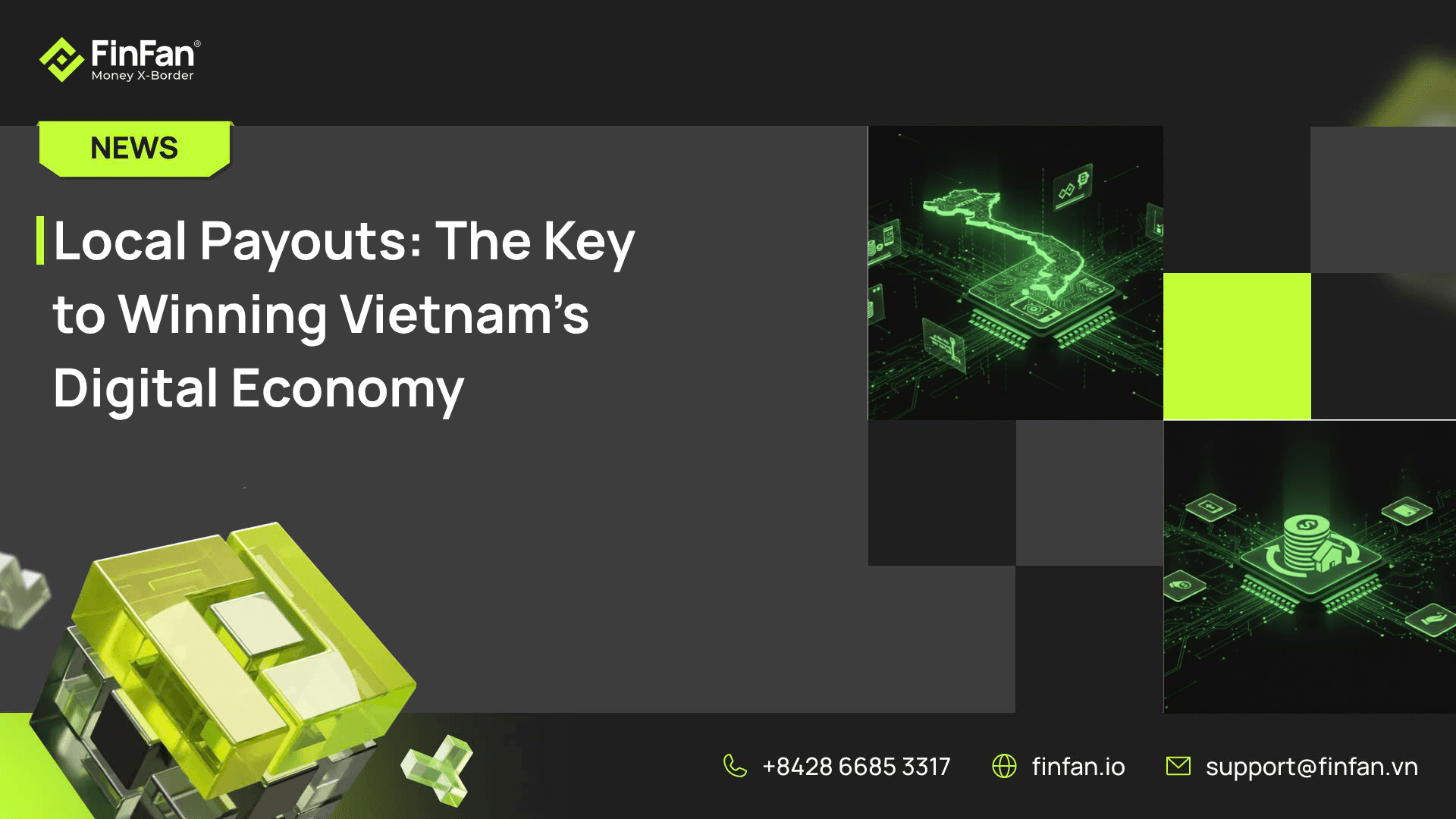Global Payment Trends 2025: The Rise Of Virtual IBANs And Next-Generation Infrastructure Empowering Vietnamese Businesses Worldwide

The world of international commerce is undergoing a dramatic transformation, and for Vietnamese businesses, this shift is more critical than ever. The days of accepting slow, opaque, and costly international payments are over. Today, the global economy demands speed, transparency, and seamless integration, and the race is on for Vietnamese enterprises to adopt a new generation of payment infrastructure.
2025 marks a turning point in this evolution. We are seeing a new paradigm emerge, one where the traditional, multi-day wire transfer is giving way to a global, interconnected payment ecosystem. At the heart of this change is the rise of the Virtual IBAN Account model, which is set to redefine how Vietnamese companies transact, receive, hold, and convert funds across borders. This article explores the seven key trends shaping this new landscape and how they are creating a world of opportunity for Vietnamese businesses.
1. Real-Time, Cross-Border Tracking Becomes the Norm
For decades, an international wire transfer felt like dropping a letter into a black box. A payment could take 5-7 business days to settle, often with multiple intermediaries adding layers of cost and complexity. Tracking was unreliable, and reconciling payments was a manual, time-consuming process. Businesses simply had to wait and hope the funds arrived.
In 2025, this all changes. Real-time or near-real-time settlement is no longer a luxury; it's a competitive necessity. Payment providers are now adopting advanced tracking protocols that provide end-to-end visibility, allowing businesses to monitor every stage of a transfer with the same precision they use to track a parcel in e-commerce.
For Vietnamese exporters, SaaS platforms, and global service providers, this shift provides a significant operational advantage:
- Predictable Cash Flow: Service-Level Agreement (SLA)-based settlements as fast as T+1 or T+2 mean businesses can more accurately forecast their finances and plan for growth.
- Transparent Fees: The opaque fee structures of the past are replaced with clear, all-inclusive pricing, eliminating hidden costs and unexpected deductions.
- Reduced Operational Friction: Automated tracking and transparent reporting drastically reduce the time spent on manual reconciliation, freeing up treasury and accounting teams to focus on strategic tasks.
This trend isn't just about speed; it’s about control and certainty. It empowers Vietnamese businesses to operate with the same confidence and efficiency as their global competitors.
2. The “Virtual IBAN-ization” of Cross-Border Money Flows
The concept of an International Bank Account Number (IBAN), once a standard limited to Europe, is now going global. For Vietnamese businesses engaged in cross border (X2B) commerce, a Virtual IBAN Account is no longer just a “nice to have” feature; it is becoming standard infrastructure.
Traditionally, receiving an international payment often meant relying on a third-party's bank account or a generic payment processor, which could cause delays and confusion for both the sender and the receiver. With a Virtual IBAN Account, a business can receive payments directly in its own name, instantly enhancing credibility and simplifying the collection process.
Companies can now hold accounts in major currencies like USD, EUR, GBP, and CAD, plus dozens of additional currencies via the SWIFT network. This enables businesses to:
- Receive payments in their own business name, building trust and appearing as a local entity to their global clients.
- Hold more than 30 currencies within a single, unified platform, eliminating the need for multiple foreign bank relationships and streamlining compliance.
- Seamlessly convert funds into VND at competitive rates and settle them directly into their domestic bank accounts without delays or unnecessary fees.
This global account approach is a game-changer. It consolidates a company's international finances into a single, easy-to-manage environment, making it easier to scale and compete on the world stage.
3. Multi-Rail, Local-First Payment Strategies
While the Virtual IBAN Account model streamlines international receivables, local payment rails remain critical for maximizing conversion and settlement efficiency. Forward-thinking providers are now integrating multi-rail payment systems to give Vietnamese businesses a "local presence" in their target markets.
This trend recognizes that different markets have different payment preferences. A provider that truly understands this will offer a comprehensive network that includes:
- Domestic Bank Networks: Leveraging local systems, such as NAPAS in Vietnam, for fast and low-cost domestic settlements.
- Card Networks: Seamless integration with major networks like Visa, Mastercard, and JCB for widespread payment acceptance.
- E-wallets and Mobile Money: Tapping into markets with high mobile penetration, where digital wallets are the preferred method of payment.
- ATM Withdrawals: Providing rapid liquidity access for businesses that need physical cash.
For example, a Vietnamese e-commerce seller could use this infrastructure to receive payments from customers in Thailand or Indonesia as if they were a local merchant. This local-first approach increases trust and conversion rates, while the funds are automatically consolidated and routed back to the business in Vietnam, maximizing speed and reducing costs.
4. Embedded Finance & One-API Connectivity
In the fast-paced world of 2025, time-to-market is everything. Businesses no longer want to juggle multiple vendors, contracts, and complex integrations for different payment needs. The trend is clear: embedded finance delivered through a single, unified API.
This “one API to rule them all” approach allows companies to integrate a full suite of financial services directly into their existing platforms with minimal effort. This empowers them to:
- Instantly open multi-currency accounts or Virtual IBANs for their clients or themselves.
- Manage collections, payouts, and foreign exchange (FX) in a single, intuitive environment.
- Plug into both local and global payment rails without the need for building bespoke integrations for each one.
For Vietnamese fintechs, marketplaces, and SaaS platforms, this is a massive advantage. It drastically reduces launch times, minimizes operational overhead, and removes the complexity of scaling internationally, allowing them to focus on their core product.
5. On/Off-Ramp Infrastructure for Stable Value Conversion
With the rise of Web3, decentralized platforms, and digital marketplaces, businesses are looking for flexible solutions to bridge the gap between traditional finance and the digital economy. The trend is the development of robust on/off-ramp infrastructure—the ability to move seamlessly between digital assets and fiat currencies.
This infrastructure is critical for the growing number of Vietnamese businesses and professionals operating in the crypto space. Features like Pay & Get Paid or Buy/Sell enable:
- Developers in the Web3 ecosystem to cash out their earnings from digital projects directly into local currencies.
- Freelancers and remote workers to accept payments in stablecoins and convert them to VND instantly and securely.
- Marketplaces to offer multi-currency settlement options to their vendors, including digital assets, expanding their reach and appeal.
In 2025, the lines between “traditional” and “digital-native” finance are blurring. Vietnamese businesses that can operate in both spheres will have a strategic edge, opening up new revenue streams and market opportunities.
6. SME-Centric Payment Corridors
Vietnamese SMEs are expanding faster into global markets than ever before, with trade lanes covering 33+ high-potential countries. Yet, they often face the same pain points as large corporations but with fewer resources:
- Difficulty in collecting payments quickly from international buyers.
- Inefficient holding and management of foreign currencies.
- High costs and delays when converting to VND and remitting to domestic accounts.
The "SME corridor" concept directly addresses these needs. It involves creating optimized payment routes and offering preferential FX rates specifically for small and mid-sized exporters, freelancers, and service providers. This tailored approach ensures that SMEs are not left behind in the global payments race, giving them the tools they need to compete effectively.
7. Compliance-by-Design & Strategic Partnerships
The global payments space is heavily regulated, and compliance can be a significant growth bottleneck. In 2025, the trend is to move beyond reactionary compliance to compliance embedded into product design from day one. This "compliance-by-design" approach minimizes the risk of service interruptions and ensures a smooth, secure user experience.
Strategic partnerships are also critical. Alliances between licensed local providers, global payment networks like Visa, and domestic banks create a powerful ecosystem that offers:
- Faster time-to-market for new services.
- Pre-approved compliance frameworks that give businesses confidence and security.
- Standardized onboarding for cross-border clients, making international expansion simpler and more reliable.
For Vietnamese enterprises, this means fewer regulatory surprises and a smoother, more secure path to scaling internationally, backed by trusted and established networks.
FinFan at the Forefront: Shaping Vietnam’s Cross-Border Payment Landscape
Virtual IBAN Collections: Aligning perfectly with the "Virtual IBAN-ization" trend, FinFan allows your business to open Virtual IBANs in your company’s name. This enables you to collect payments in over 30 currencies from around the world, building trust with your international clients and streamlining your receivables. You can hold, convert, and remit these funds to your Vietnamese accounts with unparalleled speed and transparency.
Speed & Cost Advantage: By leveraging multi-rail infrastructure and optimized payment corridors, FinFan delivers 1–2 day settlement times for most corridors—a dramatic improvement over traditional methods. Our commitment to transparent, low fees and competitive FX rates ensures that more of your money stays in your business.
Multi-Rail Infrastructure: FinFan’s robust infrastructure integrates with local bank networks, card networks, e-wallets, mobile money, and ATMs. This "local-first" routing strategy ensures that your transactions are not only faster and cheaper but also perfectly tailored to the unique payment landscape of your target markets.
Built for SMEs and Enterprises Alike: Whether you are a small exporter, a growing SaaS company, or a large enterprise, FinFan offers a solution that scales with you. Our API-first architecture allows for easy integration, giving you the power to manage your global payments from a single, unified environment, just as the embedded finance trend demands.
Open Your Global Payment Corridor
The global economy in 2025 rewards agility, transparency, and cross-border reach. The businesses that will succeed are those that embrace innovation and adopt a modern, global-first approach to their payments.
Vietnamese businesses that choose to adopt Virtual IBAN + multi-rail payment solutions will unlock faster cash flow, reduce costs, and gain greater control over their international transactions.
Are you ready to transform your global payments and open new doors for your business? Connect with us to learn how FinFan can empower you to succeed in the new era of global commerce.





